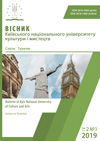Шопінг-туризм як вагомий потенціал розвитку туристичних дестинацій. Частина 1. Теоретико-методологічні засади
DOI:
https://doi.org/10.31866/2616-7603.2.1.2019.173018Ключові слова:
туризм, торгівля, шопінг-туризм, теоретико-методологічні засади, розвиток туристичних дестинацій, державна підтримка, економічний потенціалАнотація
Розвиток шопінг-туризму є явищем, яке все більше привертає уваги науковців, бізнесу та державних органів. В статті розглянуто та узагальнено основні теоретичні підходи до шопінг-туризму, що розвивалися протягом останніх років. Проаналізовано практичний симбіоз між туризмом і торгівлею, що дозволяє висвітлити економічний потенціал, який дві галузі демонструють при скоординованій роботі, а також роль державних та місцевих органів самоуправління в стратегії розвитку територій, пов’язаних з шопінг-туризмом. Нещодавно шопінг-туризм відкрив нові канали свого розвитку таким чином, що став однією з мотивацій подорожі до певної туристичної дестинації.Посилання
Cerdeño, V.M. (2019). Trade and tourism. Two sides of the same coin. Retrieved from https://worldshoppingtourism.com/en/trade-and-tourism-two-sides-of-the-same-coin/ [in English].
Dimanche, F. (2003). The Louisiana tax free shopping program for international visitors: a case study. Journal of Travel Research, 41(3), 311–314. https://doi.org/10.1177%2F0047287502239044 [in English].
Foo, J-A., McGuiggan, R., & Yiannakis, A. (2004). Roles tourist play: an Australian perspective. Annals of Tourism Research, 31(2), 408–427. https://doi.org/10.1016/j.annals.2004.01.002 [in English].
Hedrick-Wong, Y., & Choong, D. (2015). MasterCard, 2014 Global Destination Cities Index. Retrieved from https://newsroom.mastercard.com/wp-content/uploads/2014/07/Mastercard_GDCI_2014_Letter_Final_70814.pdf [in English].
Jansen-Verbeke, M. (1991). Leisure shopping: a magic concept for the tourism industry? Tourism Management, 12(1), 9–14. https://doi.org/10.1016/0261-5177(91)90024-N [in English].
Kim, S., & Littrell, M.A. (2001). Souvenir buying and intentions for self versus others. Annals of Tourism Research, 28(3), 638–657.https://doi.org/10.1016/S0160-7383(00)00064-5 [in English].
Lehto, X.Y., Cai,L.A., O’Leary, J.T., & Huan, T.-C. (2004). Tourist shopping preferences and expenditure behaviours: the case of the Taiwanese outbound market. Journal of Vacation Marketing, 10(4), 320–332. https://doi.org/10.1177%2F135676670401000404 [in English].
Magadán, M., & Rivas, J. (2014). Turismo de shopping [Shopping tourism]. Oviedo: Septem Ediciones [in Spanish].
Meng, F., Xu, Y., Hedrick-Wong, Y., & Choong, D. (2012). Tourism shopping behavior: Planned, impulsive, or experiential? International Journal of Culture, Tourism and Hospitality Research, 6(3), 250–265. https://doi.org/10.1108/17506181211246401 [in English].
Moscardo, G. (2004). Shopping as a destination attraction: an empirical examination of the role of shopping in tourists’ destination choice and experience. Journal of Vacation Marketing, 10(4), 294–307. https://doi.org/10.1177%2F135676670401000402 [in English].
Park, K., Reisinger, Y., & Noh, E. (2009). Luxury shopping in tourism. International Journal of Tourism Research, 12, 164–178. https://doi.org/10.1002/jtr.744 [in English].
Pelechá, A. (2011). Turismo de shopping: El turismo de shopping como nueva tipología de turismo [Shopping tourism: Shopping tourism as a new type of tourism]. Universidad de Valencia [in Spanish].
Reisinger, Y., & Turner, L. (2002). The determination of shopping satisfaction of Japanese tourists visiting Hawaiiand the Gold Coast compared. Journal of Travel Research, 41(2), 167–176. https://doi.org/10.1177%2F004728702237417 [in English].
Shandor, F.F., & Kliap, M.P. (2013). Suchasni riznovydy turyzmu [Modern varieties of tourism]. Kyiv: Znannia [in Ukrainian].
Swanson, K.K., & Horridge, P.E. (2006). Travel motivations as souvenir purchase indicators. Tourism Management, 27, 671–683. https://doi.org/10.1016/j.tourman.2005.03.001 [in English].
The Cabinet of Ministers of Ukraine. (March 16, 2017). Rozporiadzhennia “Pro skhvalennia Stratehii rozvytku turyzmu ta kurortiv na period do 2026 roku”, № 168-r [The Order “On Approval of the Strategy for the Development of Tourism and Resorts for the Period until2026”, No. 168-p]. Retrieved from https://zakon.rada.gov.ua/laws/show/168-2017-%D1%80 [in Ukrainian].
The Globe Shopper Index. (2015). The Globe Shopper Index European. Retrieved from http://globeshopperindex.com/en/Download/european_paper [in English].
Timothy, D. (2005). Shopping Tourism, Retailing and Leisure. Buffalo, NY: Channel View Publications [in English].
Tosun, C., Temizkan, S.P., Timothy, D.J., & Fyall, A. (2007). Tourist shopping experiences and satisfaction. International Journal of Tourism Research, 9, 87–102. https://doi.org/10.1002/jtr.595 [in English].
Travel industry association of America(2001). The Shopping Traveler. Washington, DC: Travel Industry Association of America [in English].
TURESPAÑA. (2014). Plan de Turismo de Compras 2015 [Purchase Tourism Plan 2015]. Ministerio de Industria, Energía y Turismo y Ministerio de Economía y Competitividad. Retrieved from: http://www.tourspain.es/Documents/Plan%20de%20Turismo%20de%20Compras.pdf [in Spanish].
Wagner, T. (2007). Shopping motivation revised: a means-end chain analytical perspective. International Journal of Retail & Distribution Management, 35(7), 569–582. https://doi.org/10.1108/09590550710755949 [in English].
World Tourism Organization. (2014). AM Reports, Global Report on Shopping Tourism (Vol. 8). Madrid: UNWTO. Retrieved from: http://cf.cdn.unwto.org/sites/all/files/pdf/am9-shopping-report_v2.pdf [in English].
##submission.downloads##
Опубліковано
Як цитувати
Номер
Розділ
Ліцензія
Авторське право (c) 2019 Володимир Антоненко, Володимир Хуткий

Ця робота ліцензується відповідно до Creative Commons Attribution 4.0 International License.
Автори зберігають авторські права на статтю та одночасно надають журналу право його першої публікації на умовах ліцензії Creative Commons Attribution License, яка дозволяє іншим особам вільно поширювати опубліковану статтю з обов’язковим посиланням на її авторів та першу публікацію.
Журнал дозволяє авторам зберігати авторські права і права на публікації без обмежень.
Автор опублікованої статті має право поширювати інформацію про неї та розміщувати посилання на роботу в електронному репозитарії установи.

